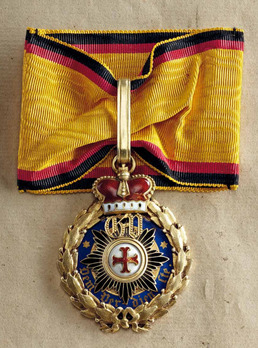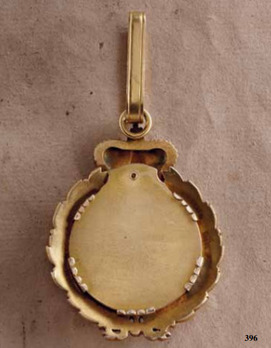Medal for Art and Science, Large
CATEGORY: Version
SKU: 02.WLD.0105.101.01.000
Estimated market value:


Estimated market value:
A circular medal, constructed of gold and enamel. The medal is surrounded by a golden laurel wreath that is tied by a ribbon at the bottom. The obverse features the eight-sided coat of arms star of Waldeck in black enamel with narrow golden edges. On the top ray is the golden monogram ‘GV’, topped by a crown with red and white enamel. Behind the crown are two golden oak leaves onto which the loop is attached. The medal around the star is enamelled in blue, it features two golden stars and the golden inscription ‘DEM VERDIENSTE’ (‘for merit’) at the bottom. The star itself features a medallion in white enamel with a red enamelled cross moline with golden edges for Pyrmont. The medallion on the star features a golden and smooth medallion ring. The reverse is golden, smooth, and blank. On a loop for suspension, on a yellow ribbon with an inner red and outer black side stripe on each side. 40 grams.
The Medal for Art and Science was originally instituted by Prince Georg Viktor as the Merit Medal. The medal was conferred upon individuals who rendered exceptional service to the princely house and contributed to the welfare of the state. On January 14, 1871, Prince Georg Viktor instituted the Order of Merit and incorporated the Medal of Merit into the order as the second class. In 1891, the medal was renamed the Gold Merit Medal.
On July 4, 1899, Prince Friedrich created a new Gold Merit Medal and the formerly awarded decoration became the Medal for Art and Science. The award was conferred in recognition of extraordinary achievements in the fields of art and science. On June 28, 1903, Prince Friedrich created the Large Medal for Art and Science. After the Large Medal for Art and Science was instituted, the Gold Medal was known as the Small Medal for Art and Science.
The medal was awarded until 1918.

Comments
Sign in to comment and reply.


Scroll Top